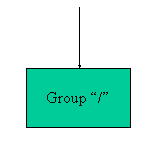
An HDF5 file is a binary file containing scientific data and supporting metadata. The primary types of objects stored in an HDF5 file, groups and datasets, will be discussed in other sections of this tutorial.
To create a file, an application must specify a filename, file access mode, file creation property list, and file access property list.
H5F_ACC_TRUNC specifies that if the file already exists,
the current contents will be deleted so that the application can rewrite
the file with new data.
H5F_ACC_EXCL specifies that the open is to fail if
the file already exists.
Note that there are two different access modes for opening exisitng files:
H5F_ACC_RDONLY specifies that the application has
read access but will not be allowed to write any data.
H5F_ACC_RDWR specifies that the application has
read and write access.
For further information, see The File Interface (H5F) section of the HDF5 User's Guide and the H5F: File Interface section of the HDF5 Reference Manual.
H5P_DEFAULT, is used.
The user-block is a fixed-length block of data located at the beginning of the file which is ignored by the HDF5 library. The user-block may be used to store any data or information found to be useful to applications.
For further information, see The File Interface (H5F) section of the HDF5 User's Guide.
H5P_DEFAULT,
is used in this tutorial.
For further information, see The File Interface (H5F) section of the HDF5 User's Guide.
The steps to create and close an HDF5 file are as follows:
C:
file_id = H5Fcreate (filename, access_mode, create_id, access_id); status = H5Fclose (file_id);FORTRAN:
CALL h5fcreate_f (filename, access_mode, file_id, hdferr, &
creation_prp=create_id, access_prp=access_id)
or
CALL h5fcreate_f (filename, access_mode, file_id, hdferr)
CALL h5fclose_f (file_id, hdferr)
In FORTRAN, the file creation property list, creation_prp,
and file access property list, access_prp,
are optional parameters;
they can be omitted if the default values are to be used.
file.h5 in the C version,
filef.h5 in FORTRAN, and then closes the file.
h5_crtfile.c fileexample.f90CreateFile.java
NOTE: To download a tar file of all of the examples, including
a Makefile, please go to the References page.
Remarks
hdf5.h contains definitions and declarations
and must be included in any program that uses the HDF5 library.
In FORTRAN:
The module HDF5 contains definitions and declarations
and must be used in any program that uses the HDF5 library.
H5Fcreate/h5fcreate_f creates
an HDF5 file and returns the file identifier.
C:
hid_t H5Fcreate (const char *name, unsigned access_mode, hid_t creation_prp,
hid_t access_prp)
FORTRAN:
h5fcreate_f (name, access_mode, file_id, hdferr, creation_prp, access_prp)
name CHARACTER(LEN=*)
access_flag INTEGER
(Valid values: H5F_ACC_RDWR_F, H5F_ACC_RDONLY_F,
H5F_ACC_TRUNC_F, H5F_ACC_EXCL_F, H5F_ACC_DEBUG_F)
file_id INTEGER(HID_T)
hdferr INTEGER
(Valid values: 0 on success and -1 on failure)
creation_prp INTEGER(HID_T), OPTIONAL
(Default value: H5P_DEFAULT_F)
access_prp INTEGER(HID_T), OPTIONAL
(Default value: H5P_DEFAULT_F)
H5F_ACC_TRUNC (H5F_ACC_TRUNC_F in FORTRAN)
will truncate a file if it already exists.
H5P_DEFAULT indicates that the
default file creation property list is to be used.
This option is optional in FORTRAN; if it is omitted, the default file
creation property list, H5P_DEFAULT_F, is used.
H5P_DEFAULT indicates that the
default file creation property list is to be used.
This option is optional in FORTRAN; if it is omitted, the default file
creation property list, H5P_DEFAULT_F, is used.
H5Fclose/h5fclose_f
must be called to release the resources used by the file. This call
is mandatory.
C:
herr_t H5Fclose (hid_t file_id)
FORTRAN:
h5fclose_f(file_id, hdferr)
/.
File Contents
The HDF team has developed tools for examining the contents of HDF5 files.
The tool used in this tutorial is the HDF5 dumper, h5dump,
which displays the file contents in human-readable form.
The output of h5dump is an ASCII display formatted according
to the HDF5 DDL grammar.
This grammar is defined, using Backus-Naur Form, in the
DDL in BNF for HDF5.
To view the file contents, type:
h5dump <filename>Figure 4.1 describes the file contents of
file.h5 (filef.h5)
using a directed graph.
The directed graphs in this tutorial use an oval to represent an HDF5 group
and a rectangle to represent an HDF5 dataset (none in this example).
Arrows indicate the inclusion direction of the contents (none in this example).
Fig. 4.1 Contents of file.h5 (filef.h5)
Figure 4.2 is the text description of
file.h5, as generated by
h5dump. The HDF5 file called file.h5 contains
a group called /, or the root group.
(The file called filef.h5,
created by the FORTRAN version of the example, has the same output except
that the filename shown is filef.h5.)
Fig. 4.2 file.h5 in DDL
HDF5 "file.h5" {
GROUP "/" {
}
}
Fig. 4.3 HDF5 File Definition
The following symbol definitions are used in the DDL:
::= defined as
<tname> a token with the name tname
<a> | <b> one of <a> or <b>
<a>* zero or more occurrences of <a>
The simplified DDL for file definition is as follows:
<file> ::= HDF5 "<file_name>" { <root_group> }
<root_group> ::= GROUP "/" { <group_attribute>* <group_member>* }
<group_attribute> ::= <attribute>
<group_member> ::= <group> | <dataset>